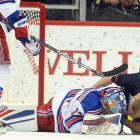
The NHL is expected to announce key changes to its concussion protocol ahead of the 2016-17 regular season. According to Elliotte Friedman of Sportsnet, the league will introduce a program that features four independent athletic trainers to monitor all games via television, looking for signs of concussions.
For the 2016-17 season, four independent trainers (called "Central Spotters") will be monitoring all NHL games via television. If they see "visible signs" of a concussion, they will send word to the team that their affected player must be removed from the game.
According to one source, the league plans to release full details shortly before the start of the regular season. From what I understand, all four independent spotters have hockey backgrounds but none are currently affiliated with an NHL club.
There will still also be team-affiliated spotters in every building.
Full details are expected to be released closer to the regular season according to Friedman. It should be noted that the league has video review centralized in their "War Room" in Toronto. It is unclear as of yet if that is where the central spotters will also be located.
This is a fascinating development and it surely is no coincidence that this is being leaked as the NFL's concussion protocol is coming under fire after Cam Newton's remaining in a game despite multiple hits to the head.
The NHL has been criticized often for the failures of its own protocol and now they're trying to add another layer. Having spotters review TV footage to determine whether a player should or shouldn't be allowed to stay in a game is sure to bring on a lot of questions, however.
While we'll have to wait and see how it all works, this theoretically allows the NHL to err on the side of caution. A trained professional, independent of any team, reviewing the factors of a hit, being able to see how the injured player reacts and making a determination looks good on paper.
The camera angles and all of the extra replays may show things an on-site athletic trainer might miss in real time. The spotters likely will have more information at their disposal than the trainers and they also won't have coaches and or injured players barking at them to let the player stay in the game.
It takes a very difficult decision out of the hands of a team's athletic trainer, which is going to have its positives and negatives. The players and coaches probably aren't going to love it, but they're not always thinking about the long-term health of the injured player in the middle of a game. This takes care of that concern for them.
It will be interesting to see how this is rolled out and if it will even be effective. With each tweak to the protocol, it usually doesn't take long for questions to be raised about the effectiveness of it.
Telling a player he has to leave a game is always tough to do, but making that a dispassionate decision with only the player's health in mind is the way to go. Hopefully this is another positive step for player safety.






















